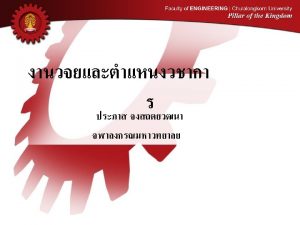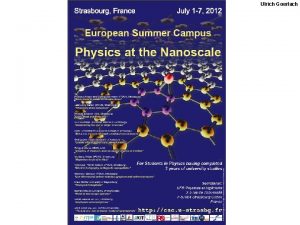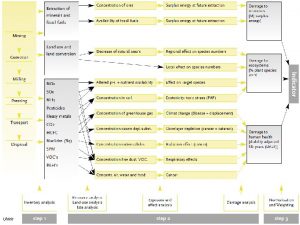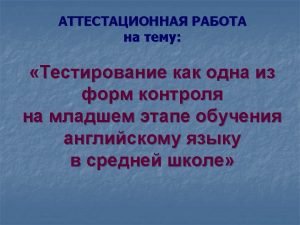For Ulrich I got to know Ulrich while




















- Slides: 20

For Ulrich I got to know Ulrich while hiking at a conference in Banff Canada more than 20 yrs ago. One year later, he offered me my first postdoc position, and I got to think for the first time in my life about experimental data. If scientific genealogy is meaningful, then Ulrich is my scientific father. I owe Ulrich more than anyone else in physics. Sons are strange: they want to differ from their parents but even where they succeed the parents recognize themself in what they do. That’s why I have chosen the following scientific story for Ulrich’s birthday.

Heavy Ion Phenomenology Ulrich is where the action is. What we fit … Bernard, Moreland, Bass, Liu, Heinz, ar. Xiv: 1605. 03954 … and what we are after … fundamental properties of hot QCD … and what we are after

On the stock market of paradigms The Bulls: • Hydro works! The Bears: • But how can hydro work? This is a story told by Ursus, the bear, about - how hydro works for non-interacting (dark matter) particles in cosmology - how effective viscosity becomes calculable in these systems

From Boltzmann Transport to Fluid Dynamics • Boltzmann equation with collision term • Momentum moments of phase space distribution: a reminder • Fluid dynamics applies if - higher moments can be truncated - perturbations around average stay small Gradient expansion of perturbations leads then to (dissipative) fluid dynamics from which the Israel-Stewart equations of motion can be derived.

From Boltzmann transport to the cosmological fluid Vlasov-Boltzmann equation: free-streaming in gravitational field • Dark matter is non-interacting but of thermal origin: => expand around average • Momentum moments: $ density $ pressure CHF Velocity gradient Shear (scalar component) CHF • Hierarchy: • Truncation of Vlasov-Boltzmann hierarchy applies if where Baumann, Nicolis, Senatore, Zaldarriaga, ar. Xiv: 1004. 2488 Hydro works since lifetime of Universe is too short to fall out of equilibrium.

Calculating the growth of cosmological structure • Truncating Vlasov-Boltzmann at lowest moments yields equations of motion • For Einstein de. Sitter Universe Crocce, Scoccimarro, ar. Xiv: 0509419 Density contrast grows exponentially on all scales k, gravitational collapse forms structures from small perturbations. • Fun for theorists: action principle • Eom follows from variation: • Stochastic initial conditions Initial spectrum of density & velocity fluctuations:

Path integrals for a classical stochastic field • Generating functional for stochastic initial conditions Matarrese, Pietroni, ar. Xiv: 0703563 • Generating functional of connected n-point functions Full propagator describes how mode k evolves in a spectrum of perturbations. • The effective dynamics of the mode k is given by the effective action • Coarse graining the effective dynamics Floerchinger, Garny, Tetradis, Wiedemann, ar. Xiv: 1607. 03453 Renormalization group flow of the effective action

Effective dynamics vs. fundamental dynamics • Task: model flowing river for wave modes k< 1/(10 m) • Simulation fails if you use the fundamental textbook viscosity of water. Why? • The dominant dissipative process is momentum transfer from long wavelength (q < k) caused by turbulent eddies. (eddy viscosity, Boussinesq 1877) • Eddy viscosity is an example of an effective viscosity: - it depends on the spectrum of exitations in the medium (it is state dependent, not a fundamental property of matter) - it depends on the scale k What I showed on the previous slide is a framework for • • identifying effective viscosity and other dissipative processes calculating the scale-dependence of the effective viscosity via an RG flow equation.

Dissipation from mode-coupling • The inverse of the retarded propagator is • Perturbatively, the ‘self-energy’ can be calculated Describes perturbatively how mode p evolves in spectrum P 0. • Eom of viscous fluid dynamics are obtained by • Matching viscous coefficients to perturbative 1 -loop ‘self-energy’ Effective viscosities depend on spectrum of initial fluctations Floerchinger, Garny, Tetradis, Wiedemann, ar. Xiv: 1607. 03453

Can we do better? • Consider scale-dependence of the effective dynamics UV k RG flow IR • We look for a solution to • If we assume that yields viscous fluid dynamic eom at scale k, then the functional RG equation reduces to a set of coupled ordinary differential equations for (for quite a few technical details needed at this step, see ar. Xiv: 1607. 03453 ) Floerchinger, Garny, Tetradis, Wiedemann, ar. Xiv: 1607. 03453

Numerical solution of RG flow • RG flow shows an IR attractor behavior: almost irrespective of the value taken by fundamental viscosity at the UV scale, one obtains almost the same phenomenologically relevant effective viscosity at intermediate scale. Floerchinger, Garny, Tetradis, Wiedemann, ar. Xiv: 1607. 03453

Comparison to data • The dynamics derived from this RG-improved effective action compares well to data: Floerchinger, Garny, Tetradis, Wiedemann, ar. Xiv: 1607. 03453

Back to Ul. RHICs: are there similar phenomena? • Thermal sound modes are an additional (calculable!) source of viscosity Kovtun, Moore, Romatschke, ar. Xiv: 1104. 1586, Phys. Rev. D 84 (2011) 025006 “Stickiness of sound” Extra contribution from sound modes is parametrically subdominant. • But what about viscous corrections from non-thermal fluctuations?

Happy Birthday!

Back-up

Numerical solution of RG flow • Time dependence is close to the perturbative result

How are fluid fluctuations described? In heavy ion physics: Perturbatively, on top of homogeneous background fields. Non-perturbatively, via numerical codes. (at photon decoupling) Gravitational collapse (at time of structure formation) Perturbative methods and N-body simulations are applied. Early. . =>. . Late In Cosmology: (at hydrodynamization) Dissipation in near-ideal fluid (at freeze-out) Can perturbative methods apply? P. T. O.

Dark Matter Properties Is Dark Matter self-interacting? Analyzing offset between DM and stars falling into cluster Kahlhoefer et al MNRAS 452, 1 (2015) suggest For non-relativistic particles of mass m and mean velocity , the shear viscosity This would sets lower bound for shear viscosity of dark matter. Consequences for dark matter fluid dynamics! But if viscosity too large, then one should not applying fluid dynamics

Cosmological Structure Formation • Described by energy conservation and Navier-Stokes, for • Closed by Poisson equation for Newtonian potential • Viscosity slows down grav. collapse but does not wash out structure Blas, Floerchinger, Garny, Tetradis, UAW, ar. Xiv: 1507. 06665, JCAP 1511 (2015) 049

Growth of structure depends on viscosity • Consider subhorizon perturbations, Corrections to perturbative evolution are , with • Assume that viscosity and pressure do not disrupt scale hierarchy 1/km shortest length scale of (effective) viscous description which leads to • Viscosity affects sufficiently small length scales only Blas, Floerchinger, Garny, Tetradis, UAW, JCAP 1511 (2015) 049
 Sta je present simple
Sta je present simple Family and friends 2 unit 6 test
Family and friends 2 unit 6 test Present simple exercises intermediate
Present simple exercises intermediate Suffixes for kind
Suffixes for kind Suffixes of friend
Suffixes of friend Do loop adalah
Do loop adalah The one who reigns forever he is a friend of mine
The one who reigns forever he is a friend of mine Know history know self
Know history know self Do deep generative models know what they don’t know?
Do deep generative models know what they don’t know? Kolposkopi px
Kolposkopi px Jag har gått inunder stjärnor text
Jag har gått inunder stjärnor text Vem räknas som jude
Vem räknas som jude Sju för caesar
Sju för caesar Tack för att ni lyssnade bild
Tack för att ni lyssnade bild Strategi för svensk viltförvaltning
Strategi för svensk viltförvaltning Vad är verksamhetsanalys
Vad är verksamhetsanalys Tack för att ni har lyssnat
Tack för att ni har lyssnat Shaktismen
Shaktismen Vad står k.r.å.k.a.n för
Vad står k.r.å.k.a.n för Centrum för kunskap och säkerhet
Centrum för kunskap och säkerhet Läkarutlåtande för livränta
Läkarutlåtande för livränta







































